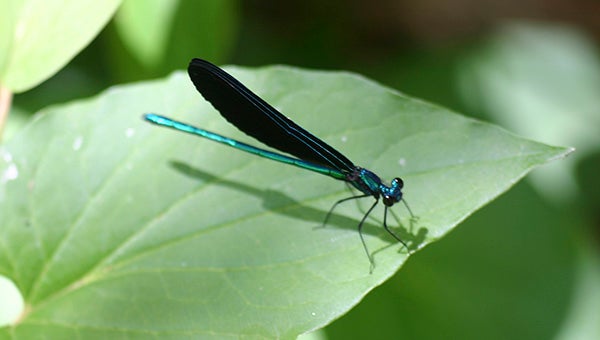Arboretum Paths: Ross E. Hutchins: A remarkable Mississippi naturalist
Published 7:00 am Saturday, August 27, 2016

This damselfly, an indicator of clean water, was photographed near the Arboretum’s Ross Hutchins Trail.
Photo by Patricia Drackett
Listening to Dr. Juan Mata’s descriptions of the mushrooms collected on last Saturday’s walk, I found myself thinking that attending one program led by an inspiring professor is much like being limited to a single piece of chocolate, one fresh-baked chocolate chip cookie, or one famous potato chip. What a treat it would be to spend an entire semester learning from a teacher like this!
My own fascination for nature was formed early in life, and never left. We hope that visitors to the Arboretum will take similar pleasure in observing the “little moments” found in the natural world, those which capture our attention and allow us to step inside another realm for a moment.
In light of our upcoming Bugfest (September 16 and 17), I’d like to introduce you to a “local hero” who would have thoroughly enjoyed this celebration of insect life. Have you noticed the interpretive trail signs for our Ross E. Hutchins trail? Dr. Hutchins taught in the Department of Entomology and Zoology at Mississippi State University in 1930, and was the department head from 1951 to 1963.
An author of many books about nature, primarily about plants and insects, his era may be long past, but his junior high level books are still highly collectable because they offer such enjoyable educational reading for adults.
Dr. Hutchins grew up on a cattle ranch near Yellowstone Park and was intrigued with nature as a child. He earned degrees in biology, zoology and entomology, and grew to be an accomplished nature photographer.
Probably his most popular book is “The Travels of Monarch X”, (Rand McNally, 1966), which tells the fascinating tale of Monarch butterfly migration. The book follows a Monarch butterfly tagged in Canada, bearing a note for the person finding it to contact the scientist who had released the butterfly. The story follows the long journey of the Monarch butterfly all the way to Mexico, where a boy caught him and contacted the scientist.
Surprisingly, I learned that I already had a Ross Hutchins book, “Hidden Valley of the Smokies” (Dodd, Mead and Company, 1971). I grew up in East Tennessee near this magnificent national park, and have pleasant memories of exploring the mountains with my family.
In this book, Dr. Hutchins describes the plant, insect and animal life found there, along with many photographs. He also generously shares the directions to his precious hidden valley.
You may be interested in a book closer to home, “Island of Adventure: A Naturalist Explores a Gulf Coast Wilderness” (Dodd, Mead & Company, 1968). The book documents Dr. Hutchins’s exploration of the plant and animal life on an island in the Pascagoula River, near its intersection with the Gulf of Mexico.
His marvelous photographs of insects and other subjects were widely published in popular natural history magazines. Over 30,000 of his images make up his “Nature in Pictures” collection, donated to the Mississippi Entomological Museum in Starkville. Some of his photos are on display in the lobby at the Clay Lyle Entomology building on the MSU campus. By the way, this lobby also features a new Arthropod Museum with live specimens!
You can find more information about Dr. Hutchins by entering his name into a search engine along with “Mississippi Entomological Museum”.
Mark your calendar for an exciting program on Saturday, September 3 at 1:00 p.m., “Life Cycle of the Monarch Butterfly”. Both children and adults will enjoy observing slides and videos of the mesmerizing process of a monarch caterpillar forming a chrysalis, transforming, and beginning life as a butterfly, with nature photographer and butterfly enthusiast Gregory Nordstrom. The program is free to Arboretum members. Cost for non-members is $5, and non-member children $2. Please call 601-799-2311 to register by September 2.
Following the butterfly program, from 2:00 to 3:00, the public is invited to attend a free opening event in the Arboretum gallery, of Gregg’s nature photography exhibit. Light refreshments will be served. The exhibit will be on display through November 30.
Our fall calendar of events will be posted later this week at www.crosbyarboretum.msstate.edu. The Crosby Arboretum is located at I-59 Exit 4 and is open Wednesday through Sunday from 9 a.m. to 5 p.m.
Patricia R. Drackett, Director and Assistant Extension Professor of Landscape Architecture
The Crosby Arboretum, Mississippi State University Extension Service





